The new Trek Rail 9.9 XX1 AXS has both muscles and brains. With its new Bosch Smart System motor, networked RockShox AirWiz suspension and countless electronic components, the Trek Rail 9.9 XX1 AXS is determined to secure the Best in Test as the best eMTB all-rounder of the year in our big 2022 eMTB group test. Will it succeed?
For an overview of the test fleet head to the group test: The best eMTB of 2022 – 13 models in review

23.52 kg in size L | € 13,599 | Manufacturer’s website
The new Trek Rail 9.9 XX1 AXS 2022 relies on the same successful concept as its predecessor, combining 29″ wheels and 160/150 mm travel. Our test bike in size L tilts the scales at 23.52 kg and retails at € 13,599. The big news for 2022 is the brand-new, neatly-integrated Bosch Smart System, the sole example of which in this test is found on the Trek. The system includes Bosch’s bar-mounted LED remote and new Kiox 300 display. The latter sits well protected on the top tube but operating the many small buttons on the remote takes some getting used to. In typical Trek fashion, the new 750 Wh battery is secured with a lock and can be removed from the side of the down tube, leaving a big 50 cm opening in the frame. Inside the downtube, foam inserts are intended to prevent the battery from rattling. However, at high speeds the battery develops a life of its own, shifting and vibrating inside of the frame.
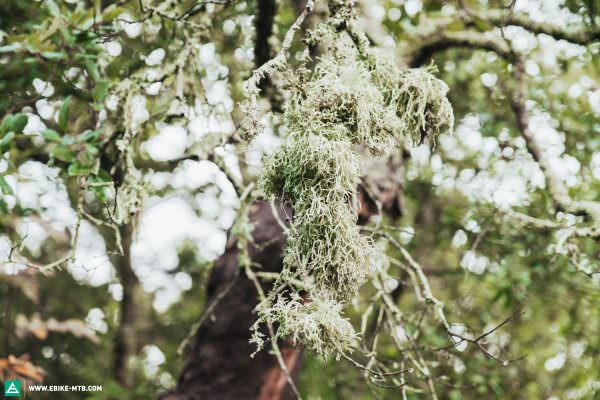

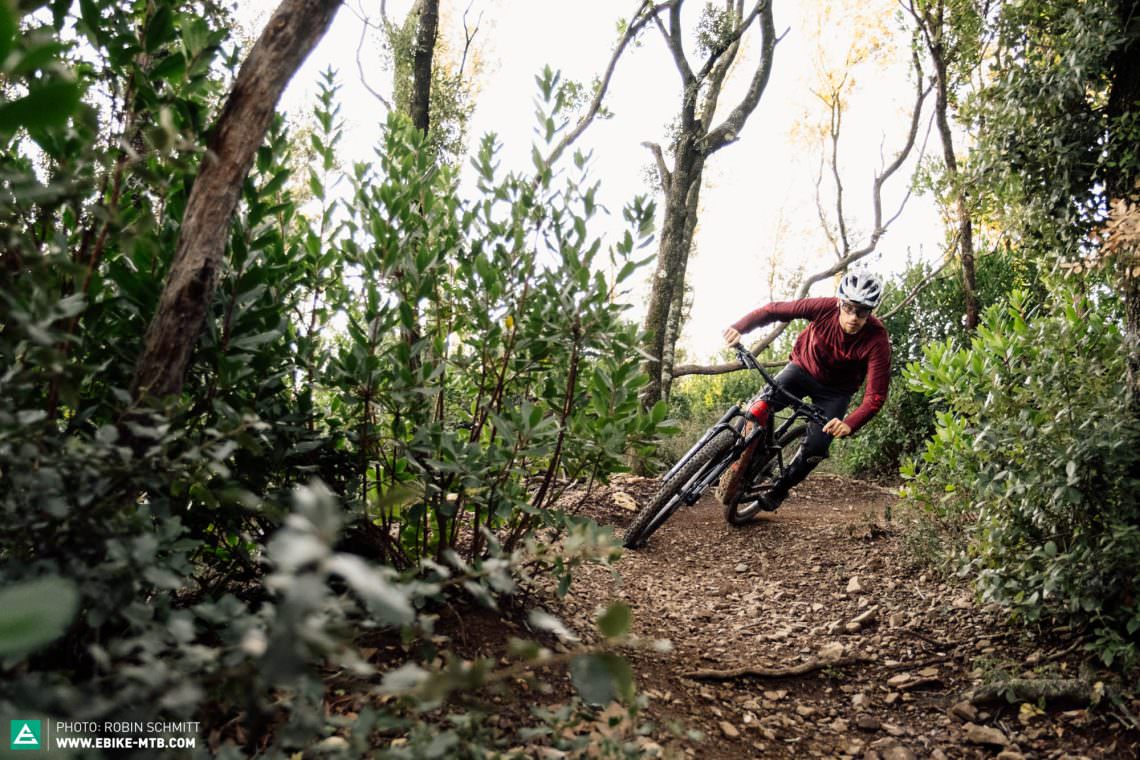
Fully networked – The spec of the Trek Rail 9.9 XX1 AXS in detail
All the electronic SRAM and RockShox components on the Rail 9.9 XX1 AXS are networked. The RockShox ZEB Ultimate fork and proprietary Super Deluxe shock with Thru Shaft technology come equipped with the new AirWiz system, which monitors the air pressure in the fork and shock and displays it on your smartphone via Bluetooth. Simultaneously, the TyreWiz sensors on the wheels allow you to check tire pressures in real time and can alert you if the pressure drops below a predetermined value. That’s a must with the puncture-prone Bontrager SE5/SE6 tires, where the thin casing could potentially lead to irreversible damage to the Bontrager Line carbon wheels if the pressures drop too low. Unfortunately, having to run fragile tires at high pressures comes at the expense of traction. A wireless XX1 AXS drivetrain delivers silky smooth shifting while SRAM CODE RSC brakes with a 220 mm front rotor and 200 mm disc at the rear ensure powerful and reliable deceleration. Although our test bike was delivered with a Bontrager Line Elite dropper post, the production bike comes with a high-quality, wireless 170 mm Reverb AXS dropper post.
Overkill! While all the electronic gadgets make setup easier, they don’t bring any real advantages to the trail.

On rough terrain, the long 750 Wh battery rattles loudly against the frame, causing the whole bike to vibrate. That quickly becomes a problem on fast descents.
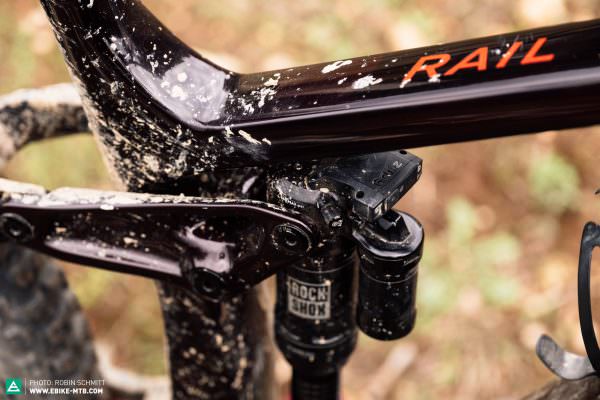
If you want to know what pressure to run in your suspension! The electronic pressure gauge connects to the SRAM AXS app via Bluetooth, sending pressure recommendations and flashing a red light if the pressure drops below the recommended setting.
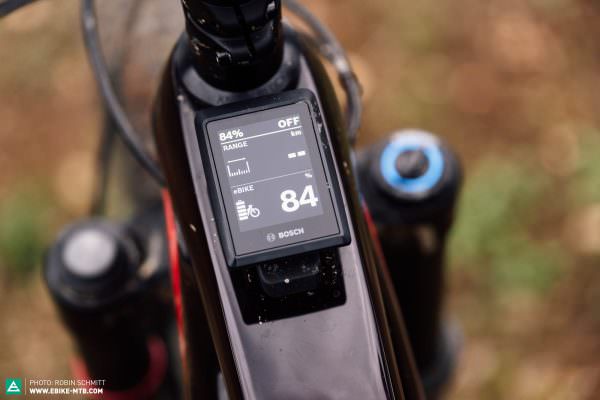
The Kiox 300 display sits safely on the top tube, where it’s protected against impacts in a crash.
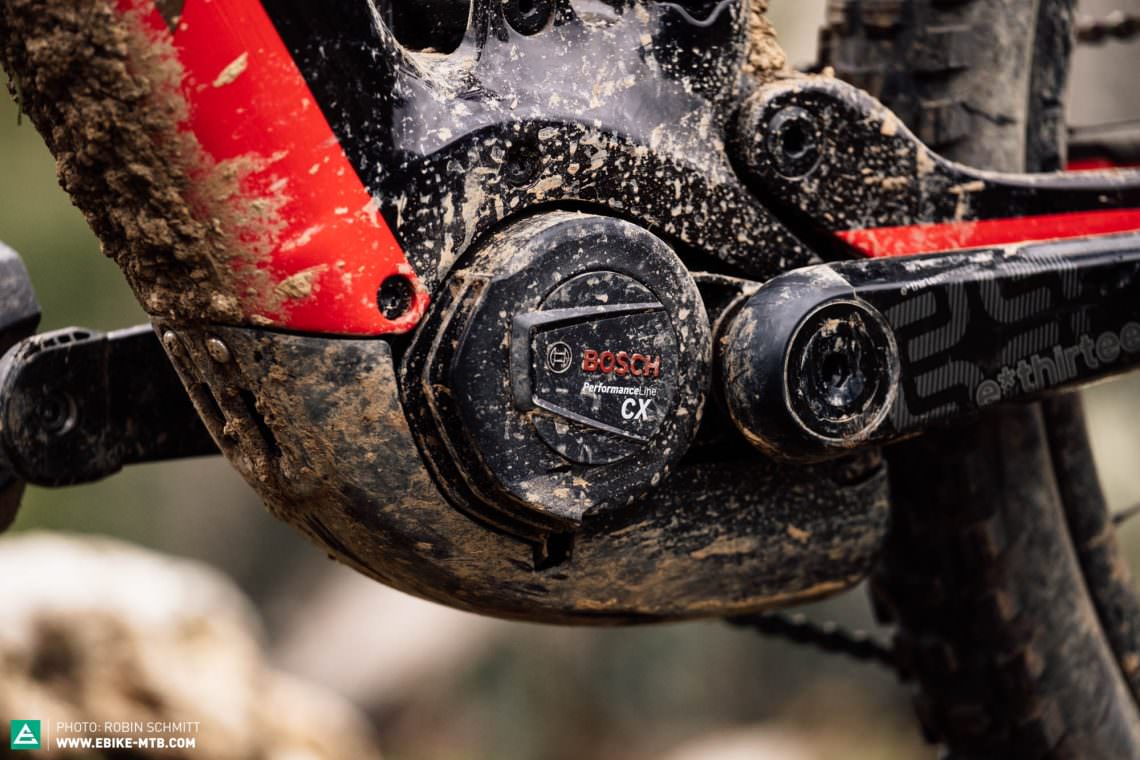
The Bosch Performance Line CX Smart System motor is neatly integrated into the frame and protected by a solid skid plate.
Trek Rail 9.9 XX1 AXS
€ 13,599
Specifications
Motor Bosch Performance Line CX 85 Nm
Battery Bosch PowerTube 750 Wh
Display Bosch Kiox 300
Fork RockShox ZEB Ultimate 160 mm
Rear Shock RockShox Super Deluxe ThruShaft 150 mm
Seatpost Bontrager Line Elite 170 mm
Brakes SRAM CODE RSC 220/200 mm
Drivetrain SRAM XX1 Eagle AXS 1x12
Stem Bontrager Line Pro 45 mm
Handlebar Bontrager Line Pro 800 mm
Wheelset Bontrager Line Pro 29"
Tires Bontrager SE5/SE6 Core Strength 2.5"
Technical Data
Size M L XL
Weight 23.52 kg
Perm. total weight 136 kg
Max. payload (rider/equipment) 112 kg
Trailer approval yes
Kickstand mount yes
Specific Features
TyreWiz
AirWiz

The thin casings of the Bontrager SE5/SE6 tires are prone to pinch flats and could end up with you damaging the Bontrager Line Pro 30 carbon rims. The TyreWiz sensor allows you to check your tire pressure and sounds an alarm if the pressure drops below a pre-programmed setting. However, high tire pressures always come at the expense of traction.

The Trek Rail 9.9 is available in three preconfigured Project One finishes. If you don’t like any of them, you can customise your own Trek Rail finish using Trek’s Project One configurator.
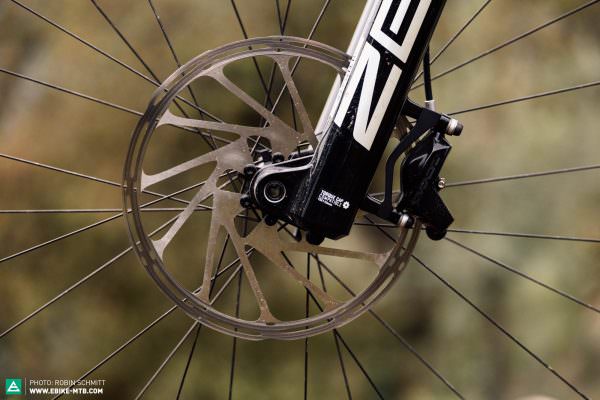
SRAM CODE RSC brakes with a 220 mm front rotor and 200 mm disc at the rear ensure reliable and powerful deceleration, good modulation and a consistent bite point, even on long descents.
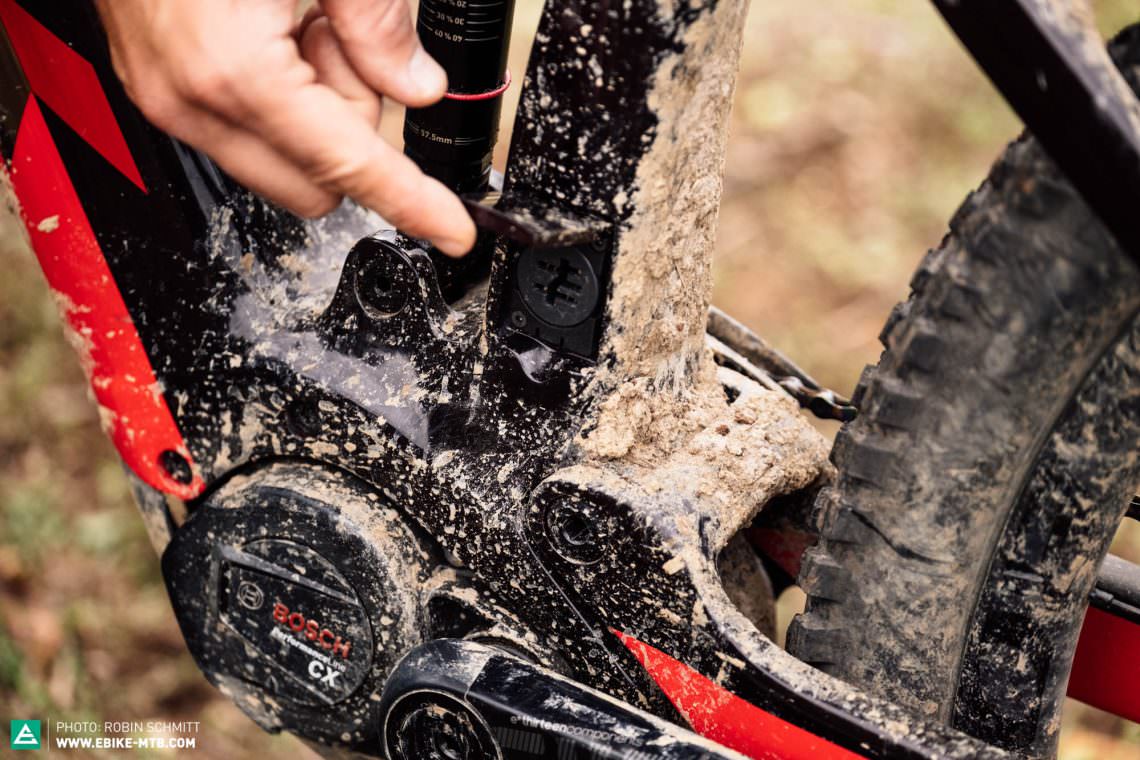
A discreet and practical cover protects the charge port from the elements.
One Trek to go, extra long, please! The geometry of the Trek Rail 9.9 XX1 AXS in detail
The Trek Rail 9.9 XX1 AXS is only available in three sizes, M to XL, because the long battery doesn’t fit into a size S frame. A flip-chip in the seat stays allows you to adjust the seat tube and head angle by 0.4°. However, in most situations, the steep setting doesn’t improve handling, which is why we recommend sticking with the slack one. At 487 mm, the Rail has the longest reach in the entire test field, suggesting a stretched and sporty riding position. That being said, the huge spacer stack under the stem ensures an upright riding position on the trail. With its firm suspension, the Trek doesn’t have the same plush touring qualities as the FOCUS JAM² or the Norco Sight VLT C1.
| Size | M | L | XL |
|---|---|---|---|
| Seat tube | 420 mm | 450 mm | 500 mm |
| Top tube | 601 mm | 639 mm | 673 mm |
| Head tube | 110 mm | 125 mm | 140 mm |
| Head angle | 64.2° | 64.2° | 64.2° |
| Seat angle | 70.8° | 70.8° | 70.8° |
| Chainstays | 448 mm | 448 mm | 448 mm |
| BB Height | 341 mm | 341 mm | 341 mm |
| Wheelbase | 1,236 mm | 1,278 mm | 1,314 mm |
| Reach | 452 mm | 487 mm | 517 mm |
| Stack | 625 mm | 634 mm | 643 mm |
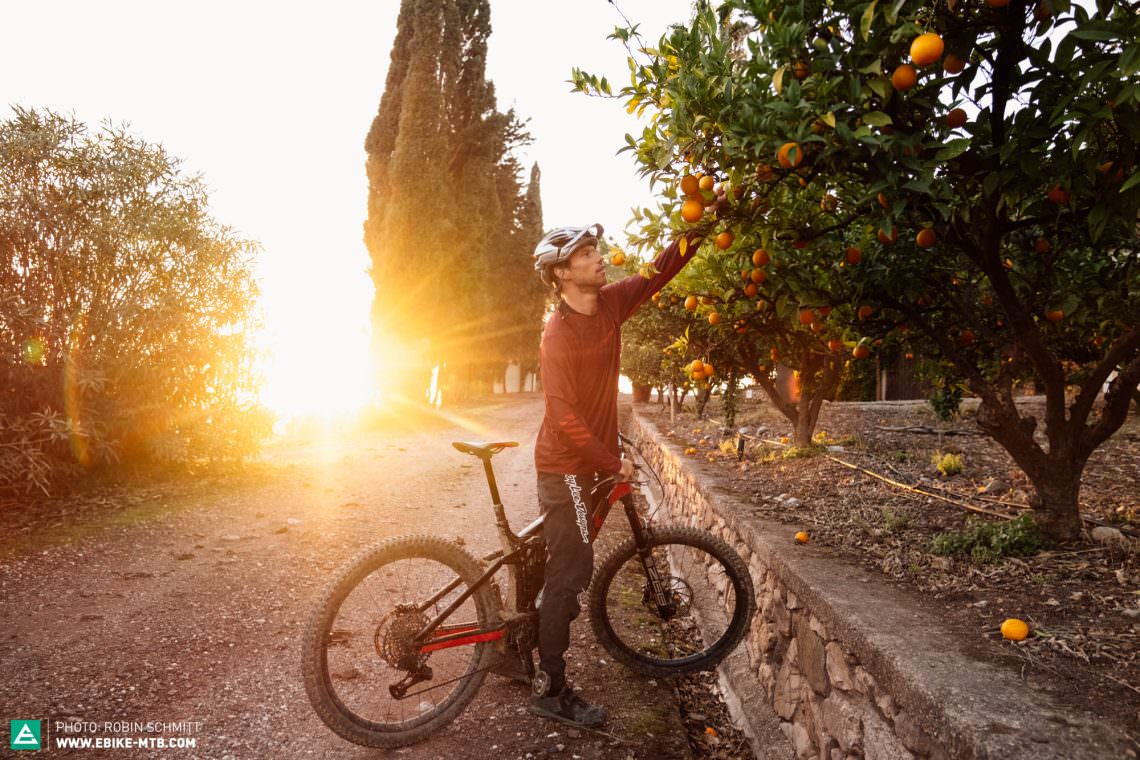
Jersey Troy Lee Designs Skyline Air LS | Pants Troy Lee Designs Sprint Ultra Pants
Kneepad Troy Lee Designs Raid | Shoes ION Rascal
A fair-weather bike? The Trek Rail 9.9 XX1 AXS uphill
The Bosch motor packs a punch from the very first pedal stroke and takes the edge off steep ramps. With its lively character, the Rail allows experienced riders to play with the terrain on their way to the trailhead and accelerate out of corners with great momentum. If you’re less experienced, you should actively weight the front to prevent the delay in motor response when off the pedals from pushing you out of corners. That being said, that lag helps you overcome obstacles on technical climbs, provided the conditions are right. Simply put, the Trek is an excellent climber on grippy terrain but reaches its limits on loose and wet terrain, where the rear wheel slips easily out of control. The firm suspension sits high in its travel, keeping the front wheel tracking on steep climbs.
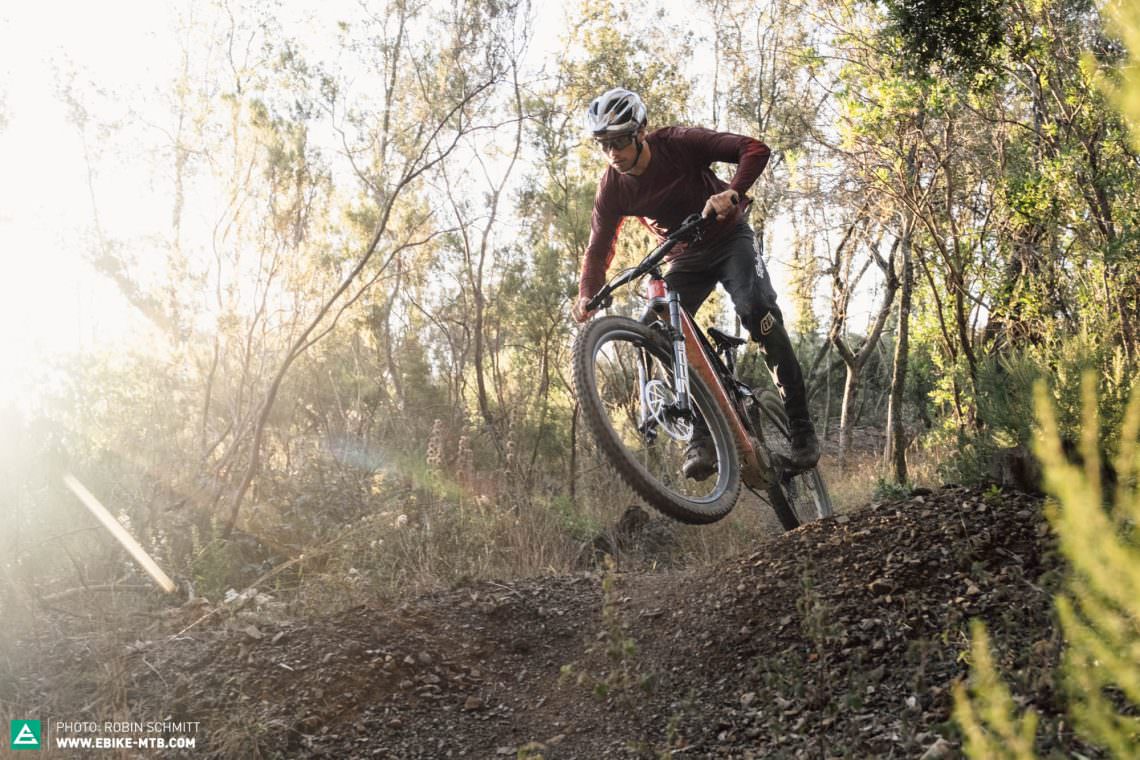
The Trek Rail carves through berms as if on rails.
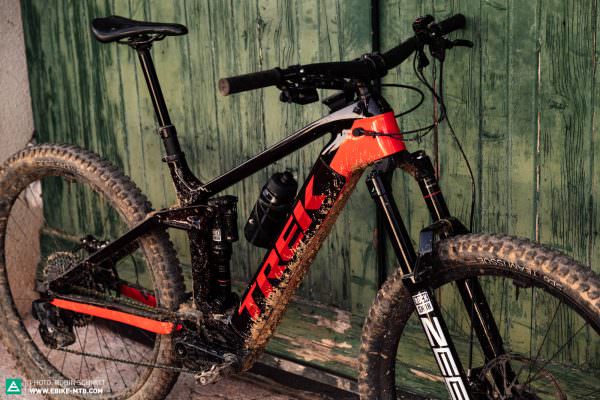
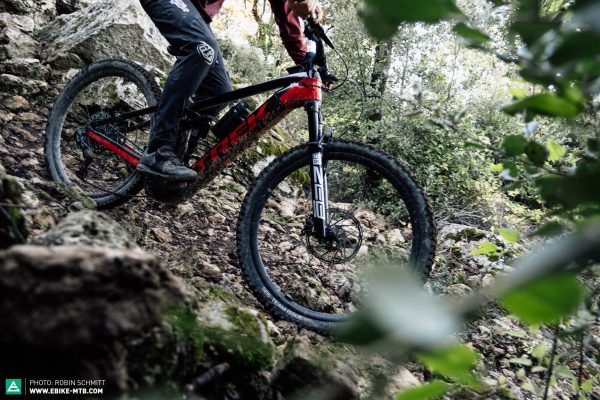

The powerful Bosch motor and firm suspension make the Rail a very efficient climber, provided you’re riding on grippy terrain. The front wheel remains planted on the ground, even when pedalling out of the saddle.
An (un)balanced downhill machine – The Trek Rail 9.9 XX1 AXS downhill
Downhill, the Rail has a penchant for man-made flow trails and offers a balanced riding position. The efficient suspension and excellent freedom of movement make it easy to pump through rollers and berms. On steep gnar with tight switchbacks, the low and central riding position prevents you from diving into the loam head first. Unfortunately, the tires generate little traction, making it hard to hold your line on slippery off-camber slabs – here the Orbea holds its line far better despite having similarly-firm suspension. On rough and fast descents with big compressions and nasty rollers, the excellent suspension releases its huge reserves efficiently and never bottoms out, even on nasty hits. However, with fast consecutive hits and hard landings, the battery rattles loudly against the frame, creating vibrations that travel all the way into the handlebars, robbing you of confidence on fast descents.
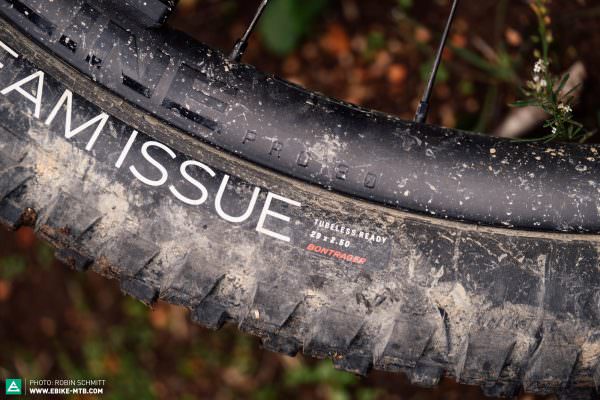
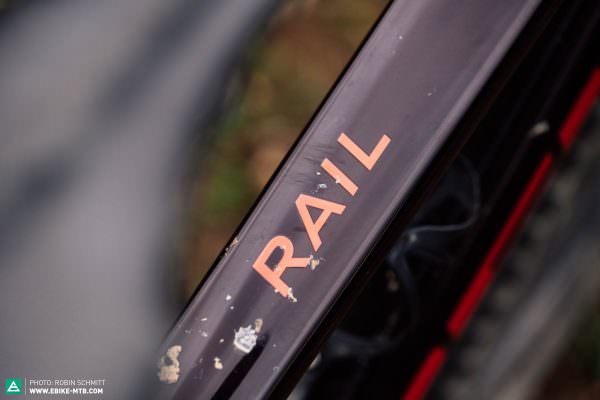
Tuning tip: more robust tires with soft rubber compound (Doubledown or Super Gravity casing)
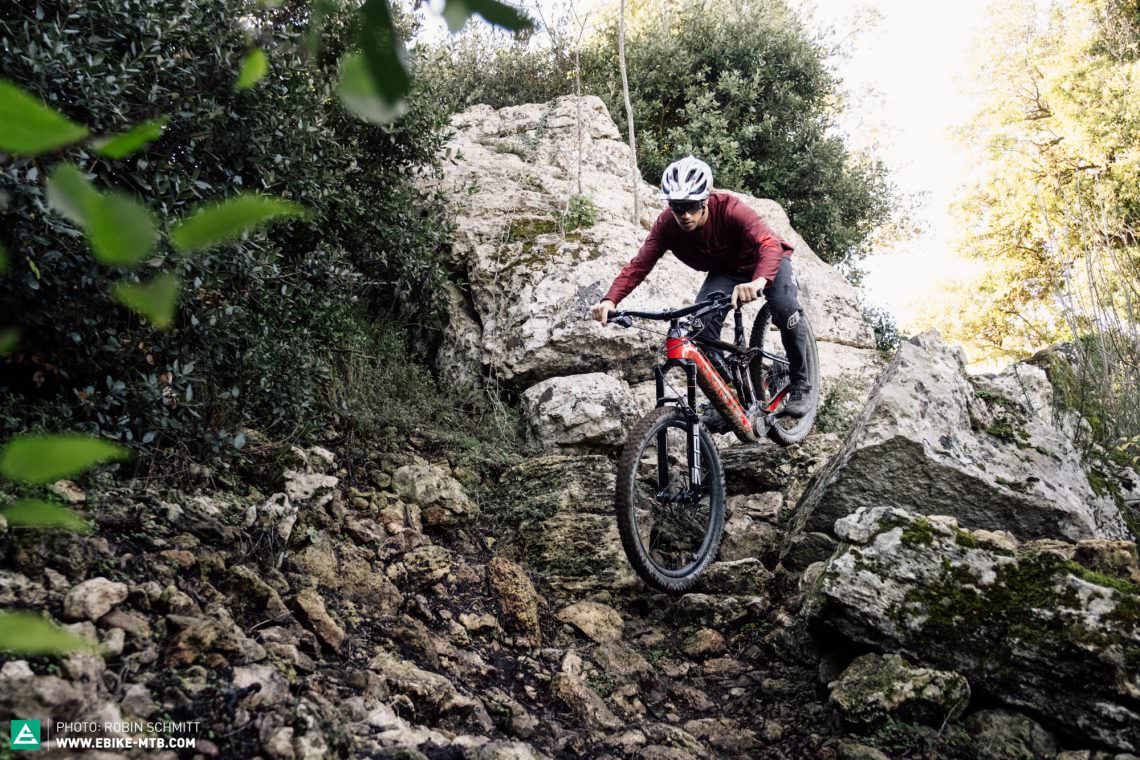
Even on very steep descents, the low bottom bracket and excellent freedom of movement prevent dreaded over-the-bar moments. However, the tires generate poor traction, affecting the sense of security on the bike.
Riding Characteristics
7Agility
- sluggish
- playful
Stability
- nervous
- stable
Handling
- demanding
- balanced
Riding fun
- boring
- lively
Motor feeling
- digital
- natural
Motor power
- weak
- strong
Value for money
- poor
- top
Conclusion
In our 2022 eMTB group test, the Trek Rail 9.9 XX1 AXS wasn’t able to assert itself against the competition in any situation. In dry, grippy conditions, it has the potential to be a very decent climber while experienced riders will be able to use the excellent suspension and freedom of movement to have fun downhill. Unfortunately, the battery rattling loudly against the frame on downhill tracks is a major issue. As a result, the Rail emerges as the clear loser in this 2022 eMTB group test. Hopefully Trek will do something about this soon.
Tops
- suspension offers plenty of reserves
- performance on technical climbs
Flops
- battery rattles loudly against the frame
- spec doesn't do justice to the potential of the bike
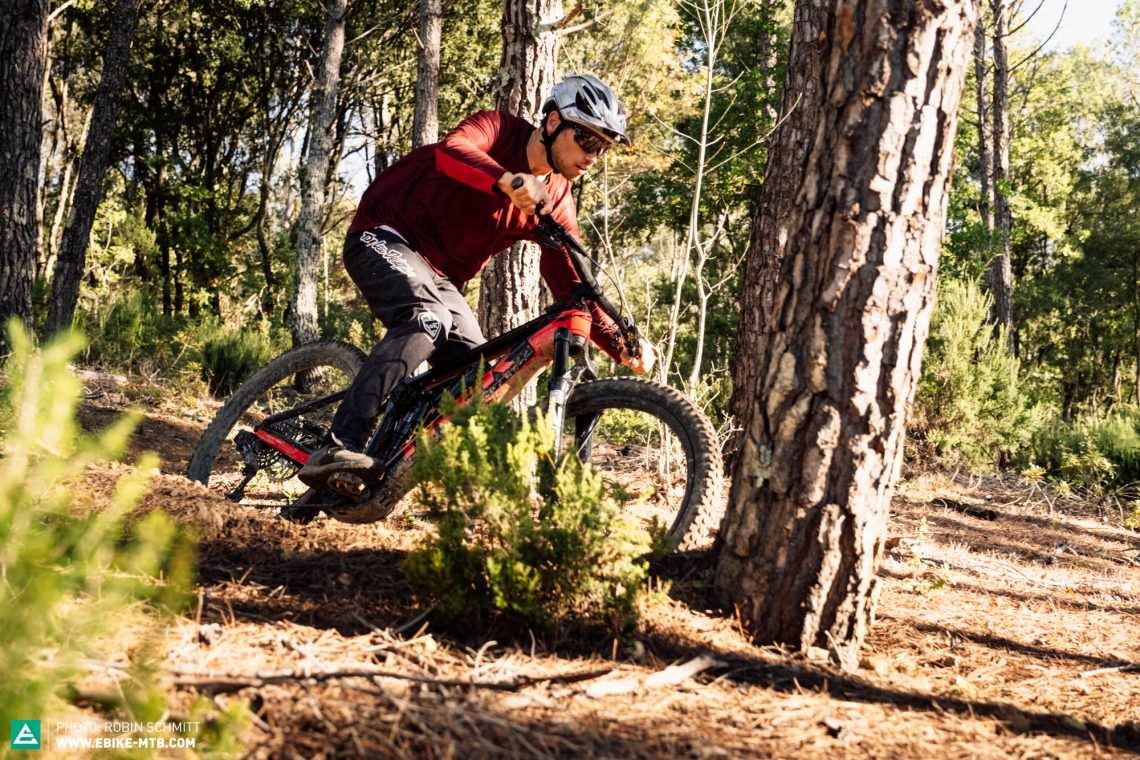
You can find out more about at trekbikes.com
The test field
For an overview of the test fleet head to the group test: The best eMTB of 2022 – 13 models in review
All bikes in test: FOCUS JAM² 7.0 (Click for review) | MERIDA eONE-SIXTY 10k (Click for review) | Norco Sight VLT C1 (Click for review) | Orbea Rise M-Team (Click for review) | Rocky Mountain Altitude Powerplay C70 (Click for review) | ROTWILD R.E375 PRO (Click for review) | SCOR 4060 Z ST XT (Click for review) | SCOTT Ransom eRIDE 910 (Click for review) | Specialized S-Works Turbo Levo (Click for review) | Specialized S-Works Turbo Kenevo SL (Click for review) | Trek Rail 9.9 XX1 AXS | Yeti 160E T1 (Click for review) | YT DECOY MX CORE 4 (Click for review)
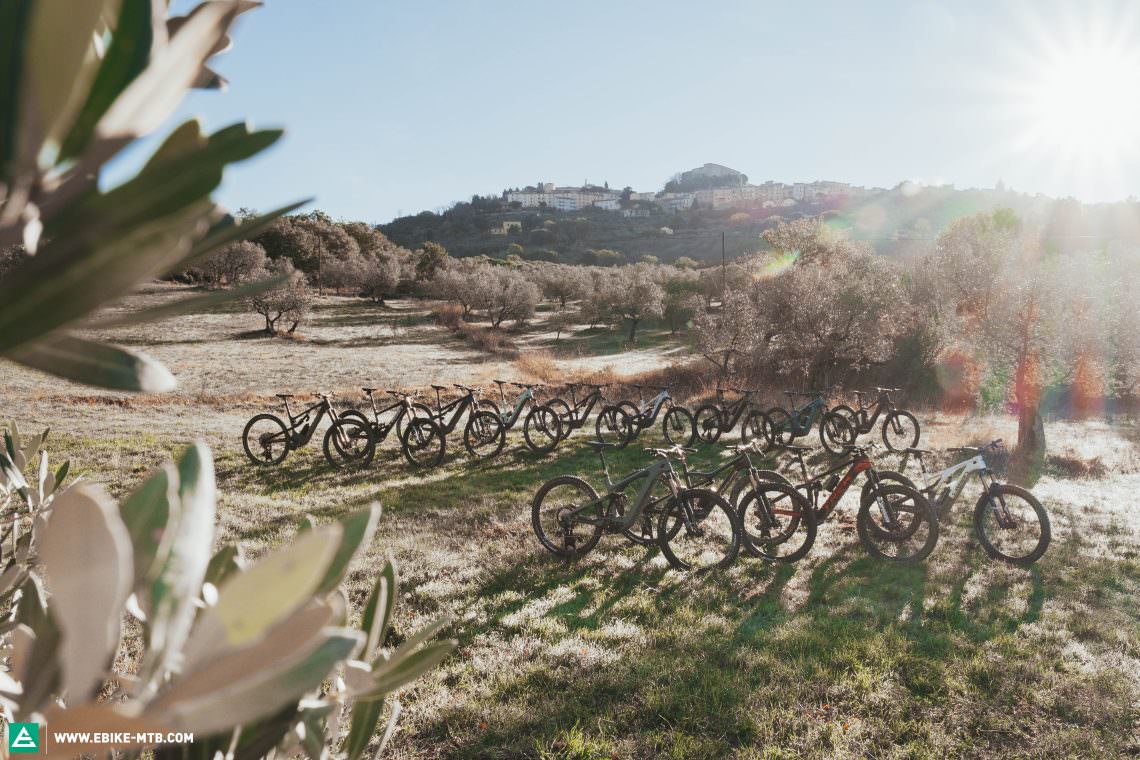
Relaxed and comfortable riding on surfaced roads, both uphill and downhill.↩
Easy climbs up trails with few obstacles, wide turns and a moderate incline.↩
Active and playful descents on easy trails with few obstacles, wide turns and a moderate slope.↩
Single-track climbs on challenging terrain. Loose ground, steps, roots, tight corners and occasionally extreme inclines.↩
Singletrack descents on challenging terrain. Loose ground, steps, roots, tight corners and small jumps as well as some very steep descents.↩
High speed descents on sometimes very rough trails with large jumps and obstacles that you can’t roll over.↩
The rating used for riding characteristics refers to the bikes in the group test and the current state of development of eMTBs. The best bikes managed to blend supposedly opposite riding characteristics, feeling both lively and stable at the same time. The handling describes the balance of the bike on downhill sections. The information regarding motor-power refers to the ride-feeling in the overall context of the bike and not exclusively to the motor – that’s why the same motor can present different values.↩
Did you enjoy this article? If so, we would be stoked if you decide to support us with a monthly contribution. By becoming a supporter of E-MOUNTAINBIKE, you will help secure a sustainable future for high-quality cycling journalism. Click here to learn more.
Words: Rudolf Fischer Photos: Robin Schmitt









